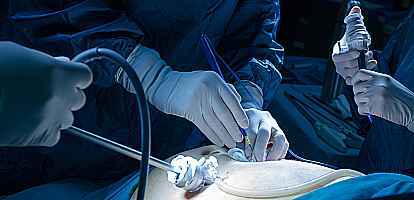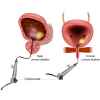Introduction
A cystoscopy, commonly known as a bladder camera test – is an examination of the inside of the bladder and the urethra (the tube that drains the bladder to the outside). This is performed with a special viewing camera. This test is more accurate than a standard ultrasound or CT imaging for diagnosing conditions inside the bladder.
About the Cystoscope instrument
There are 2 types of cystoscopes (cameras); a flexible cystoscope and a rigid cystoscope. When a cystoscopy is needed for simple diagnostic reasons, a flexible cystoscopy is done because it can be done under local anaesthetic. If more complex additional procedures are anticipated, then a rigid cystoscopy is done. A rigid cystoscope allows more instruments to be used through it and it is more uncomfortable for the patient, hence it is done under a general or spinal anaesthetic, or IV sedation (in women).
Under what circumstances is Cystoscopy used?
Cystoscopy may be used to help diagnose certain conditions, for example:
- Bladder cancer.
- Stones.
- Infections.
- Ulcers.
- Anatomical abnormalities.
- Causes of blood in the urine (haematuria).
- Foreign body (e.g., suture material).
Cystoscopy may be used to assist the surgeon during certain procedures related to the urinary tract, for example:
- TURP (transurethral resection of the prostate).
- TURBT (transurethral resection of the bladder).
- Bladder biopsy.
- Kidney stone surgery.
- Diagnosing kidney or ureteric (tube that drains the kidney to the bladder) tumours.
How do I prepare for it?
The test should take about 15 to 30 minutes. Sometimes, you may be told to withhold certain medications for a period of time before the test. Inform your doctor if you are on blood thinners or diabetic medications.
If it is done under local anaesthetic, then it will be a day case and you can go home on the same day. In this case, you do not have to do any special preparation like fasting before the test. After the test, you can also drive home.
If a general anaesthetic or IV sedation is to be given, then you will have to follow the usual protocol of 6 hours of fasting prior to the procedure. Your doctor will give you more instructions before the test. You may still be able to go home on the same day depending on the type of procedure done together with the cystoscopy. However, it is advisable that someone else drives you home. Do not undertake any of the following activities for 24 hours: driving a car, operating machinery, handling hot cooking instruments, drink alcohol.
See preparing for surgery, for more instructions.
What are the side effects?
Most patients should be able to resume normal activities after an outpatient test. You are expected to experience some of the following:
- Burning in the urine.
- Voiding more frequently than usual.
- Mild blood in the urine.
This will usually subside after a day or two. If they persist, then you may be experiencing a bladder infection and you should seek medical attention.
Complications
The overall complication rate is low, but the possible complications are:
- Urinary tract infection:
- Associated symptoms are urinary frequency, difficulty holding back the urine, smelly / cloudy urine and occasionally, fevers.
- Drink lots of water to prevent this.
- In some circumstances, you may be given a course of antibiotics after the test to prevent an infection.
- Persistent bleeding:
- Especially in patients who are on blood thinning medications or those who had more complex procedures done.
- Drink lots of water to treat this.
- If you are passing large blood clots or heavily blood-stained urine and/or cannot pass urine, then you should seek medical attention.
- Urinary retention (cannot pass urine):
- This can happen in men with an enlarged prostate.
- Injury to the urethra or bladder.
- Risks of the general anaesthetic such as heart or lung problems.

